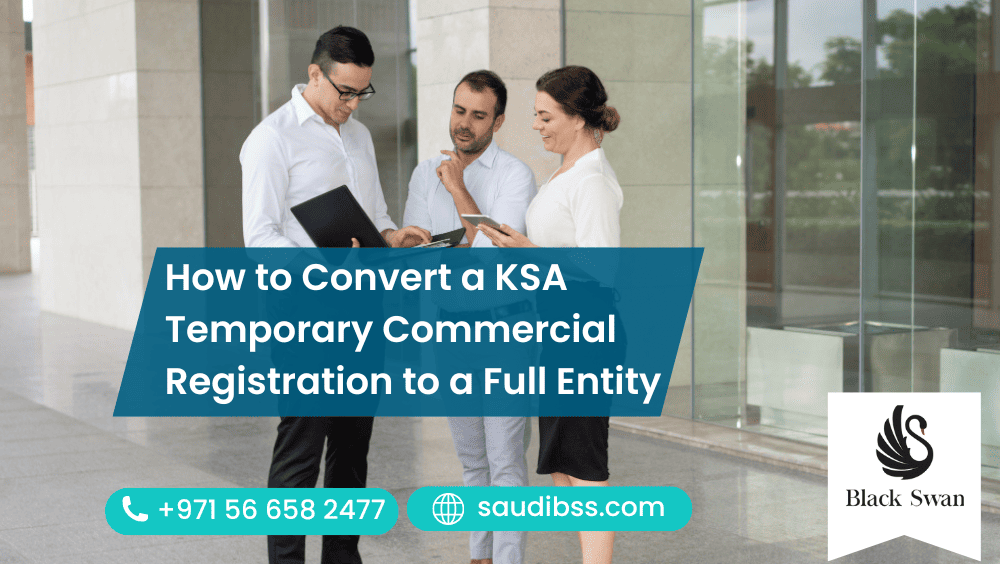Winning a project or testing the market with a Temporary Commercial Registration (TCR) is a smart way to enter Saudi Arabia. Anyhow, once momentum builds, you’ll want the flexibility to bank with ease, bid on new work, invoice widely, and hire, .Therefore That’s when you convert the temporary CR into a full Commercial Registration (CR) with a proper legal form. Below, we lay out a clear, practical roadmap that shows how to move,who approves what, and what to prepare, from project-based permissions to a permanent Saudi presence—quickly and cleanly.
Table of Contents
Start with the end in mind: what “full entity” actually means
A full entity in Saudi Arabia holds a live Commercial Registration (CR) under the Ministry of Commerce (MoC) with a defined legal form—typically an LLC or a branch. It can sign multi-year leases, employ staff, open a corporate bank account, register with ZATCA (Zakat, Tax and Customs Authority), join the Chamber of Commerce, secure municipality (Balady) licenses, and operate on the national platforms (Qiwa, GOSI, Mudad, and Absher Business). In short, you move from “single project permission” to “ongoing business rights”. Get details on Business Setup in KSA.
Step 1: Confirm eligibility and close out TCR obligations
Before you upgrade, tidy the past. Saudi authorities expect clear compliance.
- Review the basis of your TCR. Was it tied to a specific government project or tender? Note any expiry or close-out clauses.
- Close project guarantees and final financial statements related to the temporary activity.
- Settle penalties and invoices so that the system shows no flags.
- Collect NOCs (((No-Objection Certificates))) if a contracting entity requires them.
- List all assets (vehicles,equipment,)normally linked to the TCR; decide which to transfer to the new entity.
Because loose ends delay approvals, this housekeeping step pays off later.
Step 2: Choose your permanent legal form
Your legal form shapes banking, tax, and hiring. Moreover Most investors pick one of two options:
- Saudi LLC (((Limited Liability Company)))
- Pros: Strong bank perception, flexible shareholding, ability to add activities, clear liability ring-fencing.
- Use cases: New market build-out, multi-client operations, future capital increases.
- Branch of a Foreign Company
- Pros: Simple governance (no share capital in Saudi), direct control by the parent.
- Use cases: Contract-led activity where the parent wants a straight line of control.
Tip: If you want local partners, consider LLC. If you plan to keep control centralised, a branch often suits. We’ll map pros and cons to your contracts, banking aims, and staffing plan. Obtaining an Commercial License in Saudi Arabia.
Step 3: Secure or amend the MISA license (for foreign ownership)
Foreign investors need a valid MISA (Ministry of Investment Saudi Arabia) license. If you worked under a temporary permission or a project-based approval, you now:
- Apply for a new MISA license (if you had none), matching your intended activities; or
- Amend your existing MISA license to move from temporary/project scope to full operational scope.
What MISA checks: parent company credentials, financials, experience, and clean legal standing. Prepare audited accounts, board resolutions, and attested corporate documents (parent CR, Articles, POA). We coordinate attestations through the Saudi Embassy chain.
Step 4: Reserve your trade name and define activities (MoC)
On the Ministry of Commerce portal, reserve a trade name that meets Saudi rules and aligns with branding. Next, pick your activities from the official catalogue. Use exact wording so you avoid rejection at later stages (banking, municipality, and ZATCA all read from this list).
- Have two back-up names ready.
- Keep the initial activity set focused; you can add more after go-live.
- For regulated sectors (healthcare, education, logistics, engineering), expect external approvals.
Step 5: Draft and notarise the Articles of Association (LLC) or branch documents
For an LLC, you’ll prepare bilingual Articles of Association (AoA) specifying capital, managers, signing powers, profit distribution, and dispute resolution. For a branch, you’ll file the parent’s board resolution, appointment of the GM, and the PoA.
- Use the Unified Notary system for digital notarisation where eligible.
- Define manager authorities clearly (banks will check this).
- Ensure the registered address (National Address) appears consistently.
Step 6: Obtain the Commercial Registration (CR)
With MISA (if needed), the trade name, and AoA/branch papers ready, submit to MoC and pay the fees. When the CR issues, you officially exist as a full entity.
What you’ll receive:
- CR certificate with your unified number
- Chamber of Commerce contribution invoice prompt
- Access to linked government portals (upon activation)
Step 7: Join the Chamber of Commerce and activate the National Address
Two quick but vital tasks:
- Chamber of Commerce: activate membership; many e-services check this status.
- National Address (Saudi Post/SPL): register your office location; banks and ZATCA rely on this record.
Because both steps are fast, we complete them the same day as CR issuance where possible. Looking for a Business Setup Consultants in KSA?
Step 8: Open the corporate bank account (and deposit capital, if LLC)
Banks in KSA expect a tidy KYC pack:
- CR, MISA license (if foreign-owned), Chamber certificate, National Address, and AoA
- GM ID/Iqama (or passport + entry) and board/PoA showing signing authority
- Business plan: who you sell to, expected volumes, key contracts
- VAT/Zakat expectations and source of funds for capital
For an LLC, deposit share capital as per the AoA. Therefore, Expect IBAN issuance once due diligence clears.
Step 9: Register with ZATCA (((Customs Authority,Tax & Zakat)))
Activate your tax profile:
- Zakat/Corporate Income Tax registration (based on legal form/ownership).
- VAT registration when you meet thresholds—or voluntarily if your model suits.
- Configure e-invoicing (FATOORA) requirements and pick compliant software.
- Align your Chart of Accounts to Saudi reporting norms.
We also set supply codes (standard, zero-rated, exempt) so your first invoice posts cleanly. Get details on Company Registration in Saudi Arabia.
Step 10: Obtain the municipality license and sector approvals
Apparently,Operating premises require a municipality license via Balady. Upload the lease, CR, floor plan (where required), and any fire safety certificates. For sectors like food, healthcare, engineering, and logistics, secure regulator-specific NOCs.
Step 11: Enable people platforms — Qiwa, GOSI, Mudad, Absher Business
Hiring and payroll run through Saudi’s integrated systems:
- Qiwa (Ministry of Human Resources): contracts, work authorisations, and Saudisation metrics.
- GOSI: social insurance registration for Saudi and expat staff.
- Mudad: WPS-compliant payroll and wage file submissions.
- Absher Business/Muqeem: immigration processes for visas and renewals.
We open and connect these accounts, assign roles, and build your onboarding checklist.
Step 12: Transfer assets and obligations from the TCR (where relevant)
If the temporary registration held equipment, vehicles, or contracts:
- Novate contracts to the new entity (customer consent may be needed).
- Transfer assets with proper valuation and documentation.
- To prevent future compliance messages you can Close the TCR formally.
This step ensures smooth audits and clean books .
Indicative timeline (((clean, well-prepared case)))
- Week 1: trade name reservation,MISA application/amendment,Eligibility check,
- Week 2: AoA/branch docs MoC filing,notarise + draft ;
- Week 3: bank KYC,National Address + Chamber ;CR issued,
- Week 4: first compliant invoice;Qiwa/GOSI/Mudad activation;Balady license;ZATCA registration;Bank account live;
A complex shareholder structures or heavily regulated activities can extend this. Nonetheless, running applications in parallel keeps the momentum high. Get details on Bank Account Opening Service in Saudi Arabia.
Banking & compliance tips that speed the conversion
- Mirror the activity description everywhere (MISA, MoC, bank forms, ZATCA). Consistency prevents queries.
- Name your GM and powers clearly in the AoA/PoA—banks check down to the clause.
- Sign your office lease early; you’ll need it for National Address, Balady, and banking.
- Stand up accounting (Xero/Zoho/QuickBooks) on day one with Saudi VAT codes and e-invoicing ready.
- Keep proof of funds for capital and operating deposits to answer bank AML questions fast.
Costs to expect (grouped for clarity)
- Government: MISA licensing/amendment, MoC CR, Chamber, Balady, sector NOCs.
- Professional: setup advisory,attestations/notarisation,translations,Legal drafting,
- Premises: utilities,fit-out (if any),Lease, .
- Banking: Minimum balance requirements (bank-specific).
- Compliance: Accounting stack, e-invoicing, payroll tools, and annual returns.
We usually provide a personalized schedule mapped to the steps above so cash flow stays predictable.
Common pitfalls (((and how to avoid them)))
- Letting the TCR lapse before migration paperwork—renew or close properly first.
- Activity mismatches between MISA and MoC—use identical titles.
- Vague manager authorities—banks reject files without clear signing rights.
- Skipping the National Address—this one small step blocks multiple portals if missing.
- Delaying e-invoicing setup—ZATCA expects readiness from day one.
Why Saudi Business Setup Service?
Because sequence, speed, and accuracy matter. We run MISA → MoC → Chamber/National Address → Bank → ZATCA → Balady → Qiwa/GOSI/Mudad, keep documents consistent, and communicate in plain English and Arabic. You get a full entity that banks can onboard, customers can contract with, and auditors can understand.
Related Articles:
» Commercial Registration in KSA: Essential Steps for Business Legitimacy
» How to do CR or Commercial business registration in KSA?
» How to Check Commercial Registration in Saudi Arabia?
» How to Obtain A Commercial License in KSA?
» New Commercial Register Law of Saudi Arabia
Quick conversion checklist
- TCR obligations closed; NOCs collected
- Legal form chosen (LLC or Branch)
- MISA license secured/amended (if foreign)
- Trade name reserved; activities aligned
- AoA/branch docs drafted and notarised
- Commercial Registration (CR) issued
- Chamber + National Address activated
- Corporate bank account opened; capital deposited (LLC)
- ZATCA + e-invoicing configured; VAT (if applicable)
- Balady license live; Qiwa/GOSI/Mudad enabled
- Assets/contracts transferred; TCR closed

Establishing Your Full Commercial Entity in KSA
A Temporary Commercial Registration gets your foot in the Saudi door; a full entity opens the whole building. Convert methodically—align MISA, lock your MoC CR, stand up banking, switch on ZATCA and e-invoicing, and enable Qiwa/GOSI/Mudad. With clean documents and parallel processing, you’ll shift from a project-bound presence to a bankable, scalable Saudi company—ready for the next tender, the next hire, and the next stage of growth.
FAQs
If foreign ownership exists, yes—MISA authorises your investment activity. Saudi-owned firms may move directly through MoC. We’ll confirm your case in minutes.
Pick an LLC if you want flexible shareholding, strong bank perception, and future capital raises. Choose a branch if you need direct parent control and a lighter governance footprint.
Normally yes, provided you meet its conditions and the TCR remains valid. Anyhow, you should transfer assets and contracts to the new CR promptly after issuance to prevent confusion.
Usually, Well-prepared cases complete in three to four weeks, including Balady,ZATCA, and bank steps. Complex shareholders or highly regulated sectors can take longer.
Apparently You can transfer employees to the new entity through novate assets/contracts and GOSI/Qiwa workflows . We’ll prepare the timelines and paperwork so operations don’t pause.

